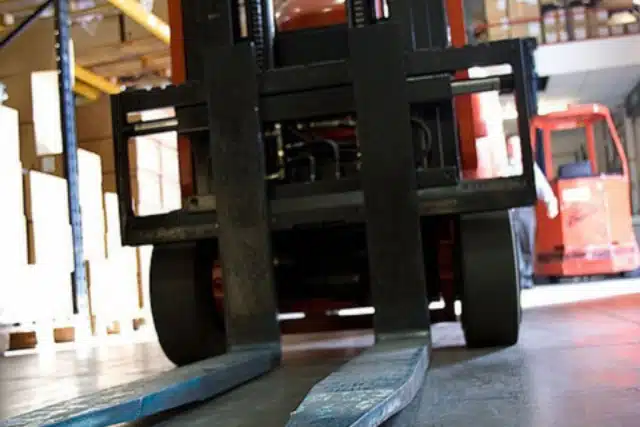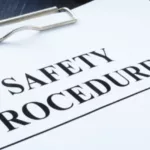June 13, 2023, is National Forklift Safety Day and an excellent opportunity to focus on forklift safety. Forklifts, also known as powered industrial trucks, are standard on construction sites, distribution centers, and manufacturing facilities, helping with efficiency. There are many types of powered industrial trucks, each unique. Weighing between 4,000-9,000 pounds, they are versatile equipment for loading and unloading supplies, moving heavy materials, and transporting goods. They are helpful as they combine a lifting tool’s functions with a vehicle’s mobility. However, working on or around forklifts/powered industrial trucks is associated with significant risks. Forklifts pose collision, falls, tip-overs, and struck-by hazards. Safe forklift operation involves proper safety training and proper forklift maintenance.
7 Tips for Forklift Safety
- Forklifts must be inspected daily and before/after each shift.
- Forklift operators must be trained and evaluated on the specific types of industrial trucks and attachments they will be operating. Employers should give refresher training as needed or in the case of an accident, incident, near miss, or if any unsafe behavior is observed. Forklift operators must be evaluated every three years.
- No one under 18 may operate a forklift.
- Forklift operators must watch for pedestrians, stay at or below the speed limit, and wear a seatbelt.
- Predetermine the weight limit per forklift model and ensure it is stable and balanced.
- Do not raise or lower the load while moving.
- Follow the manufacturer’s instructions and consult the owner’s manual for safe operation and maintenance instructions.
Often, forklifts are used around loading docks. Special care should be taken to ensure everyone’s safety in these situations. Engineering controls must be considered first, and proper PPE such as gloves, straps, eye protection, steel-toed boots, and high-visibility vests must be provided based on the hazards present.
Guardrail systems, a safety net, or a personal fall protection system may be required to prevent falls. Some best practices around loading docks include keeping working surfaces clear and painting the edge of the loading dock to ensure visibility. Communication is critical to control traffic in the area and reduce the risk of collisions.
Forklifts can be extremely dangerous if not operated correctly and can cause fatalities and injuries in the workplace. Employees can lose limbs, be crushed by a forklift, or be struck by the load falling from the forklift. In some cases, employees are struck by the forklift. While traveling down an incline, an employee attempted to turn, struck a pothole, and the forklift began to tip over. The employee tried jumping from the forklift but was struck and killed. Regardless of how the injuries and fatalities occur, they are tragic events.
Some of the common causes of forklift fatalities and injuries include:
- Operators who are not properly trained, distracted, or under the influence of drugs or alcohol can cause serious accidents. Operators can drive too fast, hit an uneven surface, and fall from the forklift. Operator error is one of the most common causes of forklift accidents.
- Overloading the forklift can cause it to tip over, leading to serious injuries or fatalities.
- Lack of maintenance and poorly maintained forklifts can malfunction, causing accidents.
- Pedestrian accidents occur when forklift operators fail to see them, causing collisions. Pedestrians and forklifts should be separated, and forklift operators must ensure bystander safety. Operators should use the horn, flashing lights, and backup alarms to alert pedestrians that a forklift is nearby. A traffic control plan should be in place.
- Falling loads occur when they are not properly secured and can fall off the forklift, causing injuries or fatalities.
Comprehensive forklift training and safe work practices help reduce the risk of forklift incidents. It is important to use proper PPE, such as hard hats, steel-toed boots, safety glasses, and gloves. Operators must drive the forklift at a speed that will allow it to be brought to a stop safely, and they must reduce speed when negotiating turns. The forklift operator must maintain visibility around the lift and use horns at cross aisles and obstructed areas. Headlights should be turned on at night and outdoors to maintain visibility. A traffic control plan is key to keeping workers safe. A forklift operator should only use a forklift for its intended purpose, following all the manufacturer’s guidelines. Forklift daily inspection checklists are also imperative for safety. Daily checklists, including fork conditions, safety devices, tire/wheel conditions, and other mechanical inspections, will help track any issues with the powered industrial truck and allow those issues to be addressed before a problem occurs. Forklifts should be kept clean and free from lint, excess oil, and grease. Remove from service forklifts found in an unsafe condition and retain daily inspection records for at least one year.
It is crucial that anyone operating a forklift is trained. To prevent forklift fatalities and injuries, it is important to provide proper training to forklift operators, ensure that forklifts are well-maintained, implement safety measures such as safety barriers and speed limits, and enforce strict safety policies in the workplace.
Remember that OSHA requires only trained and certified workers to operate a forklift. Forklifts can be dangerous, but serious injuries and deaths can be prevented with proper training. Proper forklift training can protect you from OSHA fines, property damage, and higher insurance premiums. Taking workplace safety seriously is essential; not only will it decrease the risk of accidents, but it will also result in increased productivity and efficiency.
Our forklift safety training covers topics such as forklift hazards, safe load- handling procedures, and OSHA regulations for forklift operators, helping you comply with OSHA safety regulations and protect your employees. To be most effective, forklift safety training should be part of your overall powered industrial truck safety program. This safety program should include hazard identification, operating procedures, recordkeeping, and best safety practices.
Contact us today at 919-417-2139 or to enroll in our forklift safety training course or to learn more about how we can help you develop a comprehensive powered industrial truck safety program.


